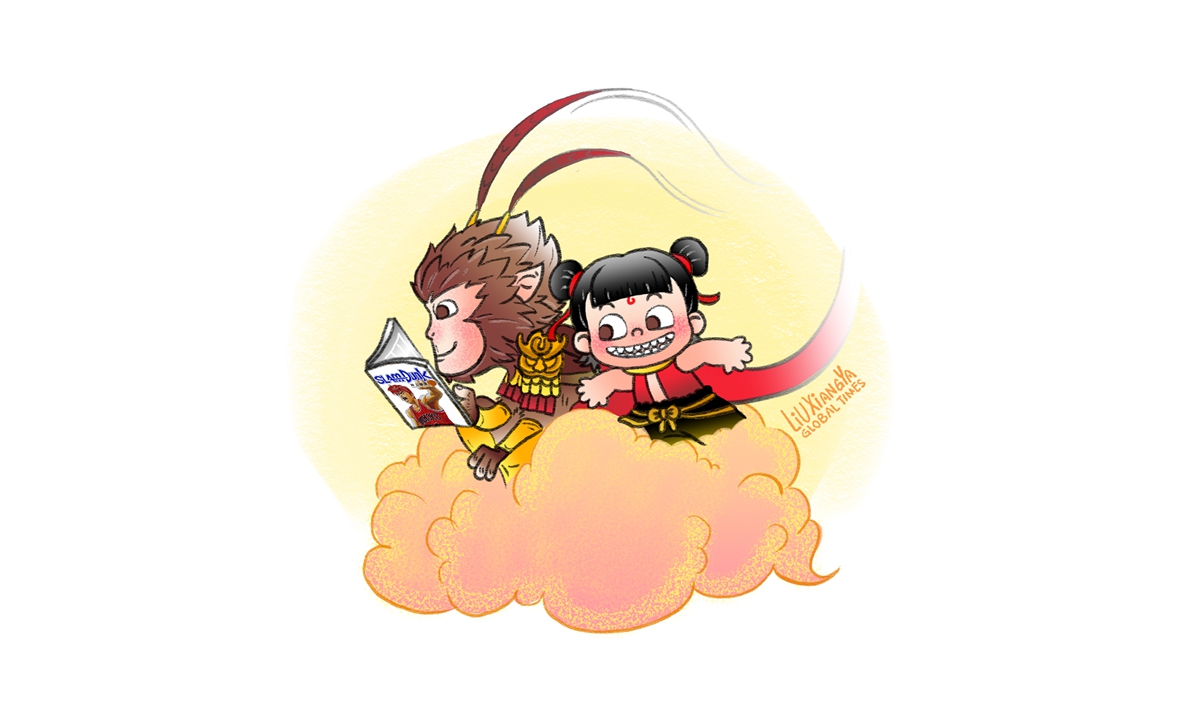
Illustration: Liu XiangYa/Global Times
Recently, the Japanese animated film
The First Slam Dunk became a hit in China. The recent May Day holidays saw the film's accumulated box office break the 600 million yuan ($86.7 million) mark, sparking a debate among Chinese netizens yet again on what Chinese animation can learn from the success of manga and anime. Some showed enthusiasm for its story, but others noted that China has also made some good animated films just like this.
It is true that Japanese animation has been successful over the past decades and spread to other countries as their stories attract younger audiences, but Chinese animators have also enjoyed a peak time and have recently been catching up by learning from the experience of others.
The First Slam Dunk tells the story of hero Ryota Miyagi's growth, from being looked down upon by his rival, the Akita Sannoh team's main point guard, to proving himself with his speed and skills and not giving up despite being injured during a game. As the soul of his team, Miyagi's enthusiasm and energy influences his teammates, and touches the hearts of the audience.
Under a government-backed charm offensive strategy, Japanese animation pays great attention to creating stories from ordinary life that can arouse empathy among people from different countries and capture the hearts of audiences of all ages, especially the young. Moreover, the Japanese animation industry boasts a mature, complete industrial chain that ranges from animators and voice actors to musicians and technical support, forming a virtuous circle.
Compared with the favorable position of Japanese animation, Chinese animation has undergone many twists and turns over the past century.
The period from 1922 to 1949 marked the starting point of Chinese animation. The Wan brothers, the pioneers of Chinese animation, produced China's first animated short in 1926. Titled
Studio Scene, it was a 10-minute black and white short with a very simple style. In 1941, China's first full-length feature animated film
Princess Iron Fan was born. In fact, it was due to the influence of this film that the Japanese animator Osamu Tezuka began to get involved in the animation industry and later became a master.
The period from 1950 to 1964 was regarded as the Golden Age of Chinese animation. Numerous excellent animated works sprang up and many new styles were created. The well-known action animation
Magic Brush won China's first international award. Another example,
Havoc in Heaven, telling the heroic story of the Monkey King, combined classic Chinese culture and animation, creating a fond memory for many people that has lasted until today.
Since China's reform and opening-up in 1978, Chinese animation also began to usher in its second development stage. Classic animated films such as
Ne Zha and
The Three Monks exploded on screen, becoming household names for the 1970 and 1980 generations. Their stories were mostly based on traditional Chinese literature and featured a typical Asian style.
However, the period between 1996 and 2014 saw a decline in Chinese animation compared with the introduction of animation from other countries, including Japan. Since 2015, Chinese animation has once again started to rise, with animated films being produced every year, such as
Monkey King: Hero is Back, and a new
Ne Zha. The
Boonie Bears movies, which are popular among young people, have traditionally hit cinemas during the Spring Festival since 2014.
In addition, the animated series
Heaven Official's Blessing began showing online in October 2020. It became greatly popular among animation fans in China and even in Japan for its meticulous script and content.
According to media reports, in 2022 the market value of Chinese animation reached 49 billion yuan, a 3 percent increase from 2021. With China's continued economic prosperity, animation has been making progress.
Animation audience is no longer limited to young children, but it has gradually become a popular means of entertainment for people of all ages. Of course, Chinese animation must further expand its scale and elaborate on its scripts on the basis of its unique charm, while also opening its arms to learn the merits of other countries' production and styles.
URL: https://www.seeglobalnews.com/read-1486.html